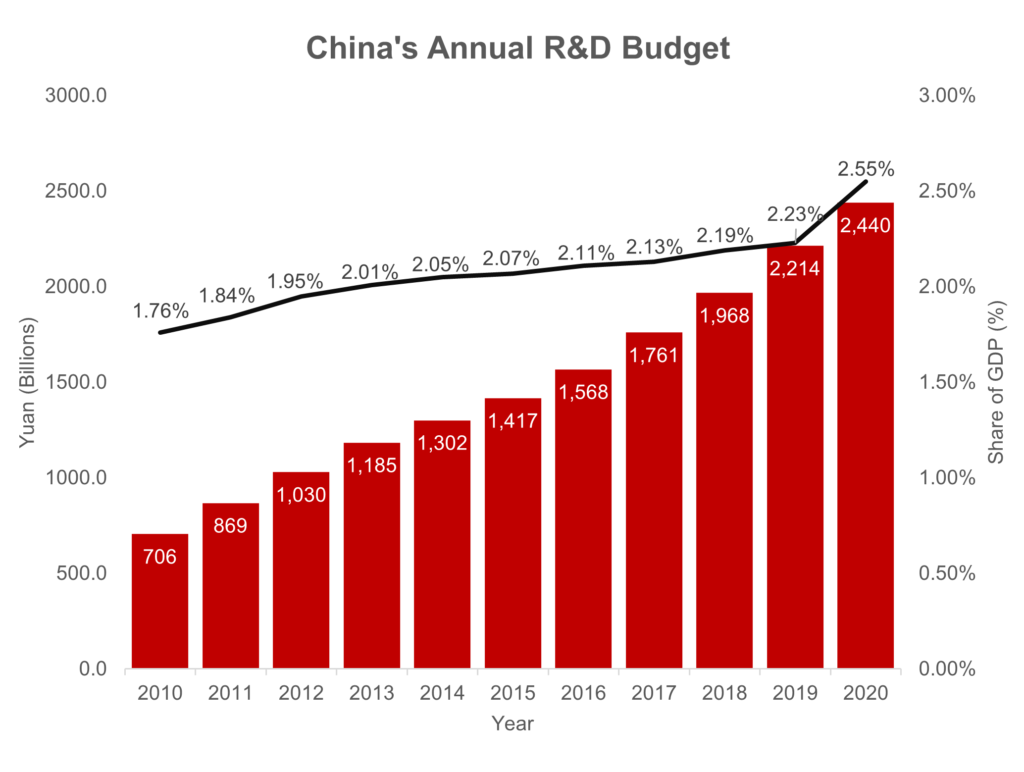The March 5-11 plenary sessions of the two organizations that make China’s national-level political decisions introduced a range of important policies which will have a significant impact on the domestic economy and society, including national and local budgets, the ambitious 14th ‘Five-Year Plan’, and initiatives in areas such as financial regulation, job creation, manufacturing, poverty alleviation and climate change. Commonly known as the ‘Two Sessions’ in China, these annual sessions are organized by the National People’s Congress (NPC) and the National Committee of the Chinese People’s Political Consultative Conference (CPPCC).
The decisions related to China’s tech policy at these sessions received enormous attention from both domestic and international observers, especially given the context of the tech war between China and the US, as well as the global supply chain constraints exposed during the COVID-19 pandemic. In the longer term, countries will be looking over their shoulders to understand other players’ policies and roadmaps, as tech interdependence gives way to tech resilience and independence.
Before delving into the policies discussed and finalized during the Two Sessions, it is important to emphasize that a single authoritative ‘plan’ rarely drives China’s technology initiatives. Instead, headline announcements are merely directives or top-level ‘gestures’ which are then followed by detailed local plans from a myriad of agencies and local government bodies.
Increased R&D Spending
The headline that grabbed everyone’s attention was the pledge to increase R&D spending by more than 7% per year between 2021 and 2025. This will also take the share of R&D spending to a higher percentage of the gross domestic product (GDP) than in the previous five years. China’s spending on R&D climbed 10% to 2.44 trillion yuan ($378 billion) in 2020, accounting for 2.6% of GDP. The country’s R&D budget eclipsed the EU’s budget last year and is projected to reach the US’s 2018 levels (the most recent year for which the data is available) by 2025.

From ‘Made in China 2025’ to ‘Sci-Tech Innovation 2030’
The ‘Made in China 2025’ plan received a huge backlash from American and European policy circles, and signs are that the policymakers in China have decided to all but shelve it. On the other hand, the ‘Sci-Tech Innovation 2030’ strategy gained momentum in 2020 and received significant coverage during the Two Sessions. The strategy is part of a broader roadmap to enable China to become a leading global innovation engine, catch up with the average income level of developed countries, and showcase strength in areas like the economy, global governance, soft power and green development.
Resources and policy priority will be given to seven critical areas – artificial intelligence, quantum computing, integrated circuits, aerospace, neuroscience, genetics and biotechnology research. Some of these also happen to be among the sectors most severely impacted by US sanctions in the past few years.

Modernization of Industrial and Technology Supply Chains
One of the strong points of the Chinese economy in 2020 was manufacturing, with the country turning in record-high trade surpluses – 2.117 trillion yuan ($325 billion) just in the last three months of 2020. Policymakers in China are doubling down on investing considerable bureaucratic and financial resources on upgrading and digitizing the country’s already-dominant manufacturing base, focusing on building a more resilient and flexible industrial chain as an important foundation for the economy.
Initiatives such as computer vision, robotics, clean energy, autonomous vehicles, cloud computing and 5G have been recognized as crucial to increasing the efficiency and productivity of factories across the country. Some of the first steps include the development of basic common standards in platforms, networks and security, and realizing data interconnection and intercommunication between platforms and industrial apps.

Recognition of ‘Digital Infrastructure’ as Strategic Initiative
The phrase ‘New Infrastructure’ gathered momentum among policymakers and observers in the second half of 2020. The 2020 stimulus package eventually included a significant amount of infrastructure spending, it focused on ‘digital, smart and innovative infrastructure’ and refrained from repeating errors similar to the ones committed a decade ago.
At the 2020 Two Sessions, the NPC introduced a digital infrastructure public spending program of around $1.4 trillion. The new infrastructure includes seven key areas: 5G networks, industrial internet, inter-city transportation and rail system, data centers, AI, ultra-high voltage power transmission, and electric vehicle charging stations. During the 2021 Two Sessions, more policy guidance, public and private participation methods, and use cases have been announced.

For detailed analysis of these topics, please refer to the full report China’s ‘Two Sessions’: Spotlight on Supply Chain Resilience and Next-Gen Technologies.

